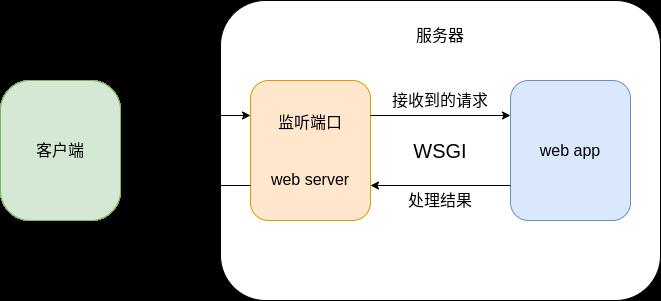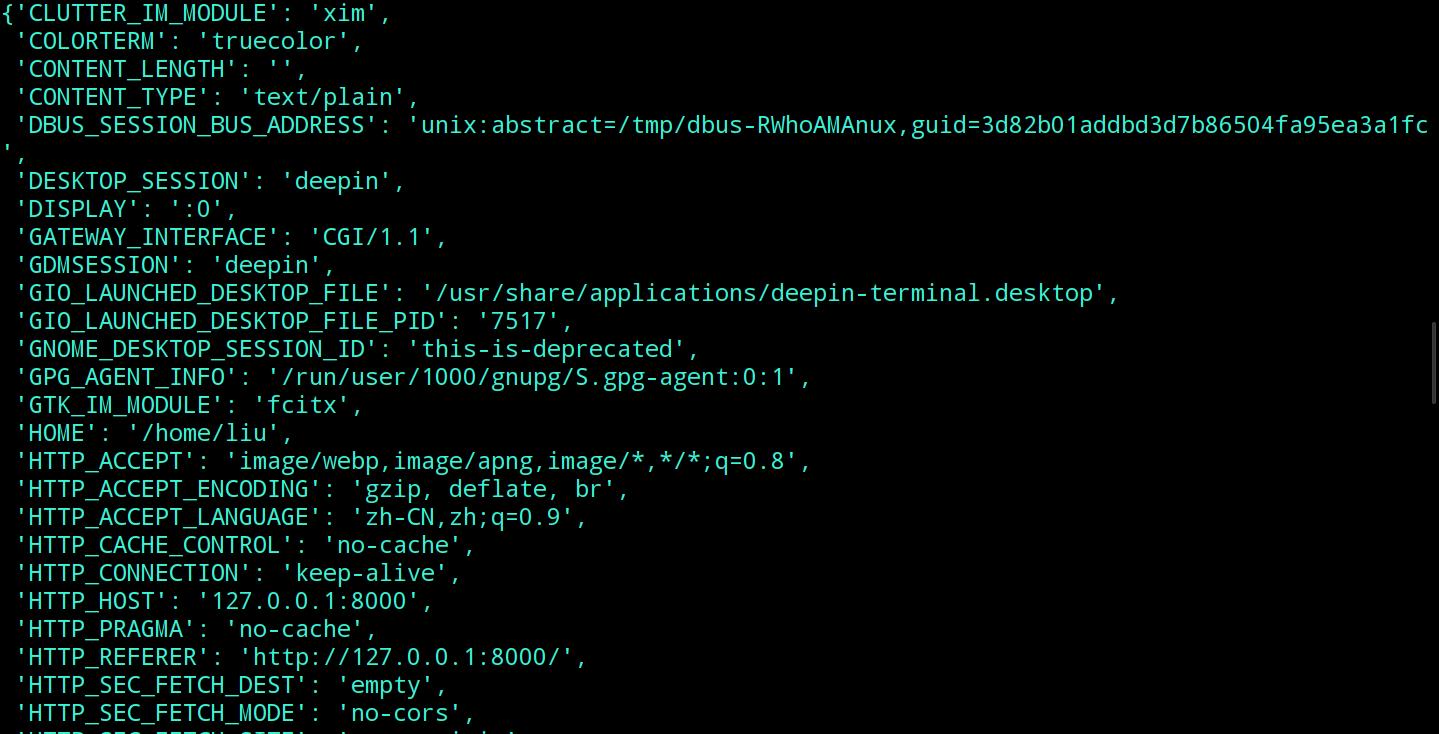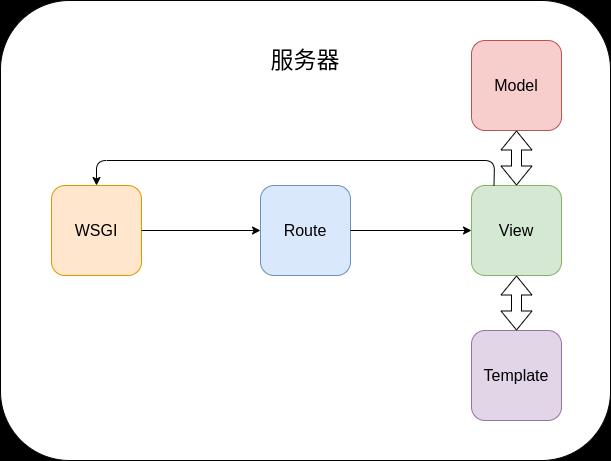写个基于WSGI的web框架
Posted 终末之冬
tags:
篇首语:本文由小常识网(cha138.com)小编为大家整理,主要介绍了写个基于WSGI的web框架相关的知识,希望对你有一定的参考价值。
一.什么是WSGI
WSGI全称Web Server Gateway Interface, 即web服务器网关接口.

如图所示的http服务器, web服务器负责面向客户端接受请求和返回响应, web应用负责处理请求, 因此二者需要进行交互, web服务器将请求数据传给web应用, web应用执行完业务逻辑后将处理结果返回给web服务器. WSGI就是通过标准接口的方式, 定义了web服务器和python web应用之间的交互规范. 对于一个python web应用, 只要它遵循WSGI规范, 理论上就可以在任何写入这个规范的服务器上运行, 这样就提高了程序的可移植性.
WSGI的接口定义很简单, 对于web应用端, 只需要定义一个类似如下的可调用对象:
from typing import List, Callable def my_application(environ: dict, start_response: Callable) -> List[bytes]: # do something status = \'200 OK\' headers = [(\'Content-Type\', \'text/html\')] start_response(status, headers) return [b\'<h1>hello wsgi</h1>\']
这个可调用对象要接收两个参数. 第一个参数environ是一个字典, 内容是客户端的请求信息, 像是下面这样:

第二个参数start_response则是一个函数, 它接收status和headers两个参数, 当后端业务逻辑执行完毕之后, 调用它就可以设置响应状态和响应头.
最后, web应用需要将响应体以字节的形式放在一个可迭代对象中返回.
这样, WSGI就定义了一个web应用的行为模式: 首先解析environ提取需要的数据, 进行各种操作后, 调用start_response函数设置响应状态和消息报头, 最后将响应正文放在可迭代对象中返回.
对于web服务器端,使用如下方式就能启动服务并调用刚才写的web应用:
from wsgiref.simple_server import make_server from app import my_application #这里的app表示web应用所在的地方, 根据自己的代码自行修改 httpd = make_server(\'127.0.0.1\', 8000, my_application) httpd.serve_forever()
这样, 一个最简单的http服务端就写好了. 访问127.0.0.1:8000, 得到结果如下:

二.web框架的架构
借用Django中MTV的那一套, 一个web框架主要包含路由, 控制器View, 模板层Template和模型层Model. web服务器将数据传给路由, 路由再将数据分发给对应的控制器去处理. 控制器与模型层交互得到数据库数据, 与模板层交互得到前端网页文件后, 将处理结果返回给web服务器.

基于上面的一套流程, 本文要实现的web框架需要实现下面的一些功能:
- Request和Response类:
分别作为environ参数和响应参数的封装, 这样可以让代码更加清晰和整洁.
- Route类:
负责路由的分发.
- Application类:
一方面作为WSGI的调用入口, 一方面进行整体的调度.
- Template:
渲染html文本, 生成动态页面
- Model:
这个不写了,因为我对数据库的了解还不够.
三.Request和Response类
Request类的代码如下:
from urllib.parse import parse_qs from typing import List class Request: def __init__(self, environ: dict) -> None: self.environ = environ self.method = environ[\'REQUEST_METHOD\'] self.path = environ[\'PATH_INFO\'] # 首先获取url中携带的参数 self.arguments = parse_qs(environ[\'QUERY_STRING\']) # 然后读取form表单参数 try: request_body_size = int(environ[\'CONTENT_LENGTH\']) except (ValueError, KeyError): request_body_size = 0 request_body = environ[\'wsgi.input\'].read(request_body_size).decode() # 最后将二者整合,表单数据中相同key的参数会把url的覆盖 self.arguments.update(parse_qs(request_body)) def __str__(self) -> str: items = ( \'arguments\', \'path\', \'method\', ) info = {item: getattr(self, item) for item in items} return str(info) def get_argument(self, key: str, default: str = \'\') -> str: values = self.arguments.get(key, None) if not values: return default return values[0] def get_arguments(self, key: str) -> List[str]: values = self.arguments.get(key, None) if values is None: return [] return values
Request类作为environ的封装. 这里只提取最常用的几个信息: 请求类型, 请求路径和url以及form表单的参数, 其他信息本文用不上, 就不提取了.
Response类的代码如下:
import http.client
from wsgiref.headers import Headers from typing import Iterable, List, Tuple class Response: def __init__(self, body: Iterable[str] = None, status_code: int = 200, content_type: str = \'text/html\', charset: str = \'utf-8\') -> None: if body is None: self.body = [] elif isinstance(body, str): self.body = [body] else: self.body = body self.status_code = status_code self._headers = Headers() self._headers.add_header(\'content-type\', f\'{content_type}; charset={charset}\') self.charset = charset def __iter__(self) -> Iterable[bytes]: for val in self.body:yield val.encode(self.charset) @property def status(self) -> str: status_string = http.client.responses.get(self.status_code, \'UNKNOWN\') return f\'{self.status_code} {status_string}\' @property def headers(self) -> List[Tuple[str, str]]: return self._headers.items()
Response类和Request类类似, 封装一些响应的基本的信息. 由于WSGI定义的接口要求返回一个可迭代对象, 因此这里定义response的__iter__方法, 将响应数据转码后返回.
通过如下方式使用上面定义的两个类:
from typing import Callable, Iterable def application(environ: dict, start_response: Callable) -> Iterable[bytes]: request = Request(environ) print(request) response = Response([\'<h1>hello wsgi</h1>\']) start_response(response.status, response.headers) return response
四.路由分发
路由的写法参照了flask, 通过装饰器的形式来指定路由分发. 代码如下:
import re from typing import ( Callable, Sequence, Tuple, ) class Route: def __init__(self) -> None: self.handlers = [] for pattern in (r\'/(favicon\\.ico)\', r\'/(robots\\.txt)\',): self.handlers.append((re.compile(pattern), static_handler)) def __call__(self, pattern: str) -> Callable: if not pattern.endswith(\'$\'): pattern += \'$\' def wrapper(handler: Callable) -> None: self.handlers.append((re.compile(pattern), handler)) return wrapper def match(self, path: str) -> Tuple[Callable, Sequence]: for pattern, handler in self.handlers: args = re.match(pattern, path) if args: return handler, args.groups() raise HttpError(404)
路由需要保存不同的url和对应的handler, 因此这里使用类而不是函数来作为装饰器, 使用handlers这个属性来保存url和对应的handler函数. 当接收到客户端的请求时, 调用路由对象的match方法就能得到对应的处理函数和url中的匹配数据. 如果无法匹配, 则通过HttpError类来引发404错误. HttpError类的代码如下:
import http.client class HttpError(Exception): def __init__(self, status_code: int = 500, message: str = \'\') -> None: self.status_code = status_code self.message = message def __str__(self) -> str: error = f\'HTTP {self.status_code}: {http.client.responses.get(self.status_code, "Unknown")}\' if self.message: return error + f\'({self.message})\' else: return error
HttpError的本质就是一个包含了状态码和错误信息的Exception, 实现这个类的好处是, 当某个流程无法继续的时候, 可以不用传参数, 而是直接将这个异常抛给上层.
另外, Route类在初始化的时候, 在路由列表中加了r\'/(favicon\\.ico)\'和r\'/(robots\\.txt)\'两项, 这两分别是网站的图标和爬虫协议, 因此交由static_handler函数处理:
def static_handler(request: Request, file_name: str) -> None: # 本文用不上,直接404得了 raise HttpError(404)
最后, 通过下面的代码测试刚才写的路由:
route = Route() @route(r\'/\') def index(request: Request) -> str: return \'hello wsgi\' @route(r\'/(.*)\') def hello(request: Request, username: str) -> str: return f\'hello {username}\' def application(environ: dict, start_response: Callable) -> Iterable[bytes]: request = Request(environ) try: handler, args = route.match(request.path) response = Response(handler(request, *args)) except HttpError as e: response = Response(status_code=e.status_code) start_response(response.status, response.headers) return response
五.Application
application的本质就是WSGI的web应用端入口. 为了方便扩展, 这里把它写成类的形式, 然后定义__call__方法;
from wsgiref.simple_server import make_server from typing import Callable, Iterable class Application: def __init__(self) -> None: self.route = Route() def __call__(self, environ: dict, start_response: Callable) -> Iterable[bytes]: request = Request(environ) try: handler, args = self.route.match(request.path) response = Response(handler(request, *args)) except HttpError as e: response = Response(status_code=e.status_code) start_response(response.status, response.headers) return response def run(self, host: str = \'127.0.0.1\', port: int = 8000) -> None: httpd = make_server(host, port, self) httpd.serve_forever()
没什么好说的, 和之前的代码是一样的.
这样一来, 一个web框架就差不多成型了, 用下面的代码进行测试:
app = Application() @app.route(r\'/\') def index(request: Request) -> str: return \'hello wsgi\' @app.route(r\'/(.*)\') def hello(request: Request, username: str) -> str: return f\'hello {username}\' if __name__ == \'__main__\': app.run()
六.模板层
关于如何实现模板层, 我单独写了一篇博客, 在这里.
七.模型层
能力不够, 先不讲了.
八.结束
把上面的代码整合起来, 我们就得到了一个web框架, 用起来像是这样:
from framework import Application, Request, render app = Application() @app.route(r\'/(.*)\') def hello(request: Request, username: str) -> str: return render(\'<h1>hello {{username}}</h1>\', {\'username\': username})
调用app.run, 就可以运行hello应用了. 此外, 也可以使用其他支持WSGI的web服务器来启动服务, 比如gunicorn:

以上是关于写个基于WSGI的web框架的主要内容,如果未能解决你的问题,请参考以下文章